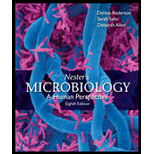
Concept explainers
Describe why a microbial mat has green, reddish-pink, and black layers.
To review:
The microbial mat having green, reddish-pink, and black layers.
Introduction:
Biofilm is a thin layer or sheet, which is composed of living organisms such as microbes that are attached to the surfaces of solids or in between the air and water faces. A microbial mat is a dense, multilayered, thick, and highly organized form of a biofilm, which is composed of colonies of mainly archaea and bacteria. These mats provide an important model for the study of microbial interactions and microbial communities.
Explanation of Solution
The microbial mats consist of several layers that are visually distinguishable. There are mainly three colored layers, which represents the growth of different microbial communities. The green colored layer is the topmost layer that consists of mainly cyanobacterial community and appears green due to the presence of green photosynthetic pigments in them and makes the organic materials. Below this, is the pink-colored layer that represents the community of purple sulfur bacteria. These are anaerobic phototrophs. The lowermost layer is black in color, which represents the community of sulfate-reducers. These are obligate anaerobic bacteria that metabolize the organic components synthesized by the upper layers of the microbial mat.
Therefore, the microbial mat represents the distinct layers of the microbial communities that are present altogether. The uppermost layer is green due to the cyanobacterial community, the pink-colored one is present in middle comprising of purple sulfur bacteria and the lowermost is black in color showing the sulfate-reducing bacteria.
Want to see more full solutions like this?
Chapter 28 Solutions
Nester's Microbiology: A Human Perspective
- please fill in the empty sports, thank you!arrow_forwardIn one paragraph show how atoms and they're structure are related to the structure of dna and proteins. Talk about what atoms are. what they're made of, why chemical bonding is important to DNA?arrow_forwardWhat are the structure and properties of atoms and chemical bonds (especially how they relate to DNA and proteins).arrow_forward
- The Sentinel Cell: Nature’s Answer to Cancer?arrow_forwardMolecular Biology Question You are working to characterize a novel protein in mice. Analysis shows that high levels of the primary transcript that codes for this protein are found in tissue from the brain, muscle, liver, and pancreas. However, an antibody that recognizes the C-terminal portion of the protein indicates that the protein is present in brain, muscle, and liver, but not in the pancreas. What is the most likely explanation for this result?arrow_forwardMolecular Biology Explain/discuss how “slow stop” and “quick/fast stop” mutants wereused to identify different protein involved in DNA replication in E. coli.arrow_forward
- Molecular Biology Question A gene that codes for a protein was removed from a eukaryotic cell and inserted into a prokaryotic cell. Although the gene was successfully transcribed and translated, it produced a different protein than it produced in the eukaryotic cell. What is the most likely explanation?arrow_forwardMolecular Biology LIST three characteristics of origins of replicationarrow_forwardMolecular Biology Question Please help. Thank you For E coli DNA polymerase III, give the structure and function of the b-clamp sub-complex. Describe how the structure of this sub-complex is important for it’s function.arrow_forward
- Basic Clinical Lab Competencies for Respiratory C...NursingISBN:9781285244662Author:WhitePublisher:Cengage
 Concepts of BiologyBiologyISBN:9781938168116Author:Samantha Fowler, Rebecca Roush, James WisePublisher:OpenStax College
Concepts of BiologyBiologyISBN:9781938168116Author:Samantha Fowler, Rebecca Roush, James WisePublisher:OpenStax College Principles Of Radiographic Imaging: An Art And A ...Health & NutritionISBN:9781337711067Author:Richard R. Carlton, Arlene M. Adler, Vesna BalacPublisher:Cengage LearningEssentials Health Info Management Principles/Prac...Health & NutritionISBN:9780357191651Author:BowiePublisher:Cengage
Principles Of Radiographic Imaging: An Art And A ...Health & NutritionISBN:9781337711067Author:Richard R. Carlton, Arlene M. Adler, Vesna BalacPublisher:Cengage LearningEssentials Health Info Management Principles/Prac...Health & NutritionISBN:9780357191651Author:BowiePublisher:Cengage





